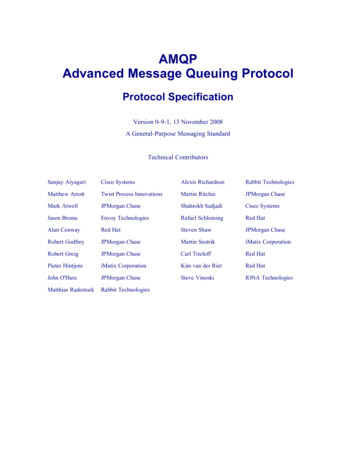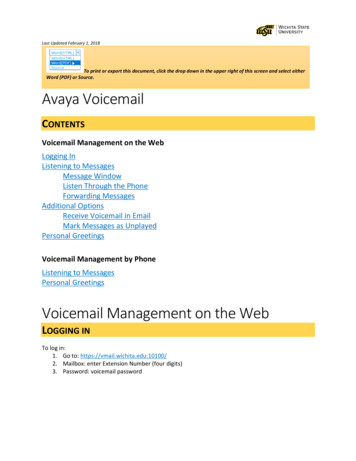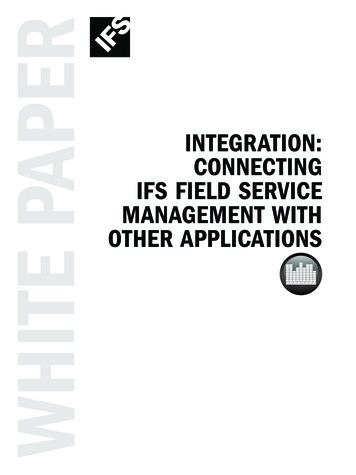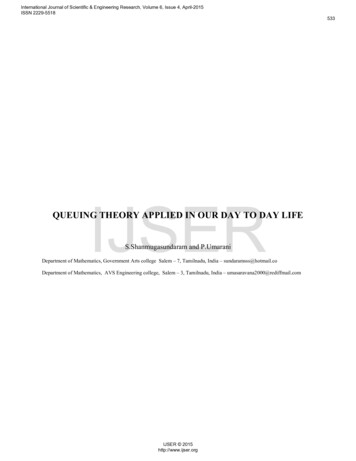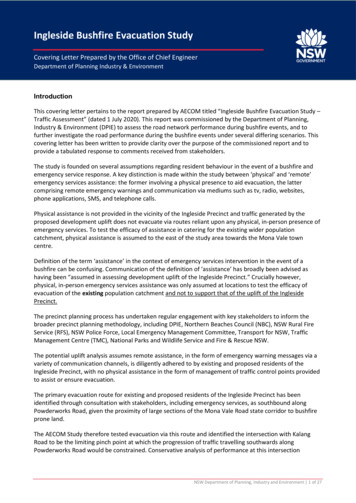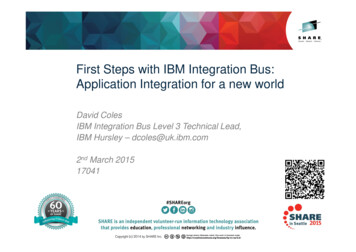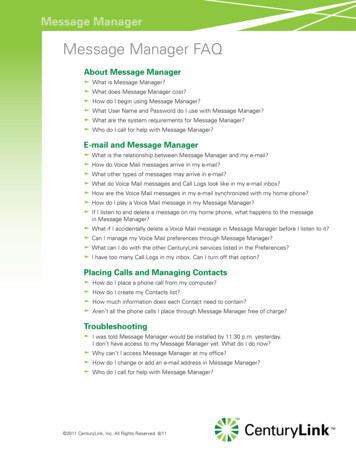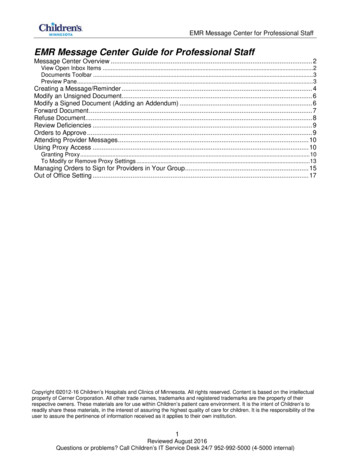![[MS-MQMR]: Message Queuing (MSMQ): Queue Manager Management . - Microsoft](/img/49/5bms-mqmr-5d-160714.jpg)
Transcription
[MS-MQMR]:Message Queuing (MSMQ): Queue Manager ManagementProtocolIntellectual Property Rights Notice for Open Specifications Documentation Technical Documentation. Microsoft publishes Open Specifications documentation (“thisdocumentation”) for protocols, file formats, data portability, computer languages, and standardssupport. Additionally, overview documents cover inter-protocol relationships and interactions. Copyrights. This documentation is covered by Microsoft copyrights. Regardless of any otherterms that are contained in the terms of use for the Microsoft website that hosts thisdocumentation, you can make copies of it in order to develop implementations of the technologiesthat are described in this documentation and can distribute portions of it in your implementationsthat use these technologies or in your documentation as necessary to properly document theimplementation. You can also distribute in your implementation, with or without modification, anyschemas, IDLs, or code samples that are included in the documentation. This permission alsoapplies to any documents that are referenced in the Open Specifications documentation. No Trade Secrets. Microsoft does not claim any trade secret rights in this documentation. Patents. Microsoft has patents that might cover your implementations of the technologiesdescribed in the Open Specifications documentation. Neither this notice nor Microsoft's delivery ofthis documentation grants any licenses under those patents or any other Microsoft patents.However, a given Open Specifications document might be covered by the Microsoft OpenSpecifications Promise or the Microsoft Community Promise. If you would prefer a written license,or if the technologies described in this documentation are not covered by the Open SpecificationsPromise or Community Promise, as applicable, patent licenses are available by contactingiplg@microsoft.com. Trademarks. The names of companies and products contained in this documentation might becovered by trademarks or similar intellectual property rights. This notice does not grant anylicenses under those rights. For a list of Microsoft trademarks, visitwww.microsoft.com/trademarks. Fictitious Names. The example companies, organizations, products, domain names, emailaddresses, logos, people, places, and events that are depicted in this documentation are fictitious.No association with any real company, organization, product, domain name, email address, logo,person, place, or event is intended or should be inferred.Reservation of Rights. All other rights are reserved, and this notice does not grant any rights otherthan as specifically described above, whether by implication, estoppel, or otherwise.Tools. The Open Specifications documentation does not require the use of Microsoft programmingtools or programming environments in order for you to develop an implementation. If you have accessto Microsoft programming tools and environments, you are free to take advantage of them. CertainOpen Specifications documents are intended for use in conjunction with publicly available standardsspecifications and network programming art and, as such, assume that the reader either is familiarwith the aforementioned material or has immediate access to it.1 / 37[MS-MQMR] - v20160714Message Queuing (MSMQ): Queue Manager Management ProtocolCopyright 2016 Microsoft CorporationRelease: July 14, 2016
Revision 1/20070.1NewVersion 0.1 release8/10/20071.0MajorUpdated and revised the technical content.9/28/20071.0.1EditorialChanged language and formatting in the technical content.10/23/20071.0.2EditorialChanged language and formatting in the technical content.11/30/20071.0.3EditorialChanged language and formatting in the technical content.1/25/20081.0.4EditorialChanged language and formatting in the technical content.3/14/20081.0.5EditorialChanged language and formatting in the technical content.5/16/20081.0.6EditorialChanged language and formatting in the technical content.6/20/20081.0.7EditorialChanged language and formatting in the technical content.7/25/20081.0.8EditorialChanged language and formatting in the technical content.8/29/20082.0MajorUpdated and revised the technical content.10/24/20083.0MajorUpdated and revised the technical content.12/5/20084.0MajorUpdated and revised the technical content.1/16/20094.0.1EditorialChanged language and formatting in the technical content.2/27/20094.0.2EditorialChanged language and formatting in the technical content.4/10/20094.0.3EditorialChanged language and formatting in the technical content.5/22/20094.0.4EditorialChanged language and formatting in the technical content.7/2/20094.1MinorClarified the meaning of the technical content.8/14/20094.1.1EditorialChanged language and formatting in the technical content.9/25/20094.2MinorClarified the meaning of the technical content.11/6/20094.2.1EditorialChanged language and formatting in the technical content.12/18/20094.2.2EditorialChanged language and formatting in the technical content.1/29/20105.0MajorUpdated and revised the technical content.3/12/20105.0.1EditorialChanged language and formatting in the technical content.4/23/20105.0.2EditorialChanged language and formatting in the technical content.6/4/20106.0MajorUpdated and revised the technical content.7/16/20107.0MajorUpdated and revised the technical content.8/27/20108.0MajorUpdated and revised the technical content.10/8/20108.1MinorClarified the meaning of the technical content.11/19/20108.1NoneNo changes to the meaning, language, or formatting of thetechnical content.2 / 37[MS-MQMR] - v20160714Message Queuing (MSMQ): Queue Manager Management ProtocolCopyright 2016 Microsoft CorporationRelease: July 14, 2016
DateRevisionHistoryRevisionClass1/7/20118.1NoneNo changes to the meaning, language, or formatting of thetechnical content.2/11/20118.1NoneNo changes to the meaning, language, or formatting of thetechnical content.3/25/20118.1NoneNo changes to the meaning, language, or formatting of thetechnical content.5/6/20118.1NoneNo changes to the meaning, language, or formatting of thetechnical content.6/17/20118.2MinorClarified the meaning of the technical content.9/23/20119.0MajorUpdated and revised the technical content.12/16/201110.0MajorUpdated and revised the technical content.3/30/201210.0NoneNo changes to the meaning, language, or formatting of thetechnical content.7/12/201210.1MinorClarified the meaning of the technical content.10/25/201211.0MajorUpdated and revised the technical content.1/31/201311.0NoneNo changes to the meaning, language, or formatting of thetechnical content.8/8/201312.0MajorUpdated and revised the technical content.11/14/201312.0NoneNo changes to the meaning, language, or formatting of thetechnical content.2/13/201412.0NoneNo changes to the meaning, language, or formatting of thetechnical content.5/15/201412.0NoneNo changes to the meaning, language, or formatting of thetechnical content.6/30/201513.0MajorSignificantly changed the technical content.10/16/201513.0NoneNo changes to the meaning, language, or formatting of thetechnical content.7/14/201613.0NoneNo changes to the meaning, language, or formatting of thetechnical content.Comments3 / 37[MS-MQMR] - v20160714Message Queuing (MSMQ): Queue Manager Management ProtocolCopyright 2016 Microsoft CorporationRelease: July 14, 2016
Table of Contents1Introduction . 61.1Glossary . 61.2References . 81.2.1Normative References . 81.2.2Informative References . 91.3Overview . 91.4Relationship to Other Protocols . 111.5Prerequisites/Preconditions . 111.6Applicability Statement . 121.7Versioning and Capability Negotiation . 121.8Vendor-Extensible Fields . 121.9Standards Assignments. 122Messages . 132.1Transport . 132.2Common Data Types . 132.2.1Structures . 142.2.1.1DL ID. 142.2.1.2MGMT OBJECT . 142.2.1.3MULTICAST ID . 142.2.1.4OBJECTID . 142.2.1.5QUEUE FORMAT . 142.2.2Enumerators . 142.2.2.1MgmtObjectType . 142.2.2.2QUEUE FORMAT TYPE . 152.2.3Property Identifiers . 152.2.3.1Management Machine Property Identifiers . 152.2.3.2Management Queue Property Identifiers . 152.3Directory Service Schema Elements . 173Protocol Details . 183.1qmmgmt Server Details . 183.1.1Abstract Data Model . 183.1.1.1Shared Data Elements . 183.1.2Timers . 193.1.3Initialization . 193.1.4Message Processing Events and Sequencing Rules . 193.1.4.1R QMMgmtGetInfo (Opnum 0) . 193.1.4.2R QMMgmtAction (Opnum 1) . 253.1.5Timer Events . 273.1.6Other Local Events . 273.2qmmgmt Client Details . 273.2.1Abstract Data Model . 273.2.2Timers . 273.2.3Initialization . 283.2.4Message Processing Events and Sequencing Rules . 283.2.5Timer Events . 283.2.6Other Local Events . 284Protocol Examples . 294.1QM Management Action and Retrieving QM Info Example . 295Security . 315.1Security Considerations for Implementers . 315.2Index of Security Parameters . 314 / 37[MS-MQMR] - v20160714Message Queuing (MSMQ): Queue Manager Management ProtocolCopyright 2016 Microsoft CorporationRelease: July 14, 2016
6Appendix A: Full IDL . 327Appendix B: Product Behavior . 338Change Tracking . 359Index . 365 / 37[MS-MQMR] - v20160714Message Queuing (MSMQ): Queue Manager Management ProtocolCopyright 2016 Microsoft CorporationRelease: July 14, 2016
1IntroductionThe Message Queuing (MSMQ): Queue Manager Management Protocol is a remote procedure call(RPC)-based protocol used for management operations on the MSMQ server, including monitoringthe MSMQ installation and the queues.Operations that a client can perform using this protocol include: Getting information on MSMQ installation and queues. Performing actions on an MSMQ installation. Performing actions on a queue.Sections 1.5, 1.8, 1.9, 2, and 3 of this specification are normative. All other sections and examples inthis specification are informative.1.1GlossaryThis document uses the following terms:active queue: A queue that contains messages or is currently opened by an application. Activequeues can be public queues, private queues, or outgoing queues.administrator: A user who has complete and unrestricted access to the computer or domain.dead-letter queue: A queue that contains messages that were sent from a host with a requestfor negative source journaling and that could not be delivered. Message Queuing provides atransactional dead-letter queue and a non-transactional dead-letter queue.directory: The database that stores information about objects such as users, groups, computers,printers, and the directory service that makes this information available to users andapplications.distribution list: A collection of users, computers, contacts, or other groups that is used only foremail distribution, and addressed as a single recipient.dynamic endpoint: A network-specific server address that is requested and assigned at run time.For more information, see [C706].endpoint: A client that is on a network and is requesting access to a network access server (NAS).foreign queue: A messaging queue that resides on a computer that does not run an MSMQmessaging application.format name: A name that is used to reference a queue when making calls to API functions.globally unique identifier (GUID): A term used interchangeably with universally uniqueidentifier (UUID) in Microsoft protocol technical documents (TDs). Interchanging the usage ofthese terms does not imply or require a specific algorithm or mechanism to generate the value.Specifically, the use of this term does not imply or require that the algorithms described in[RFC4122] or [C706] must be used for generating the GUID. See also universally uniqueidentifier (UUID).handle: Any token that can be used to identify and access an object such as a device, file, or awindow.Interface Definition Language (IDL): The International Standards Organization (ISO) standardlanguage for specifying the interface for remote procedure calls. For more information, see[C706] section 4.6 / 37[MS-MQMR] - v20160714Message Queuing (MSMQ): Queue Manager Management ProtocolCopyright 2016 Microsoft CorporationRelease: July 14, 2016
message: A data structure representing a unit of data transfer between distributed applications. Amessage has message properties, which may include message header properties, a messagebody property, and message trailer properties.Microsoft Message Queuing (MSMQ): A communications service that provides asynchronousand reliable message passing between distributed applications. In Message Queuing,applications send messages to queues and consume messages from queues. The queuesprovide persistence of the messages, enabling the sending and receiving applications tooperate asynchronously from one another.MSMQ Directory Service server: An MSMQ queue manager that provides MSMQ DirectoryService. The server can act in either of the MSMQ Directory Service roles: Primary SiteController (PSC) or Backup Site Controller (BSC).MSMQ site: A network of computers, typically physically collocated, that have high connectivity asmeasured in terms of latency (low) and throughput (high). A site is represented by a site objectin the directory service. An MSMQ site maps one-to-one with an Active Directory site whenActive Directory provides directory services to MSMQ.opnum: An operation number or numeric identifier that is used to identify a specific remoteprocedure call (RPC) method or a method in an interface. For more information, see [C706]section 12.5.2.12 or [MS-RPCE].outgoing queue: A temporary internal queue that holds messages for a remote destinationqueue. The path name of an outgoing queue is identical to the path name of thecorresponding destination queue. An outgoing queue is distinguished from its correspondingdestination queue by the fact that the outgoing queue is located on the sending computer. Theformat name of an outgoing queue is identical to the format name used by the messages toreference the destination queue. Messages that reference the destination queue using adifferent format name are placed in a different outgoing queue.path name: The name of the receiving computer where the messages for a particular queue arestored, and an optional PRIVATE key word indicating whether the queue is private, followed bythe name of the queue. Path names can also refer to subqueues; for more information, see[MS-MQMQ] section 2.1.private queue: An application-defined message queue that is not registered in the MSMQDirectory Service. A private queue is deployed on a particular queue manager.queue: An object that holds messages passed between applications or messages passedbetween Message Queuing and applications. In general, applications can send messages toqueues and read messages from queues.queue journal: A queue that contains copies of the messages sent from a host when positivesource journaling is requested.queue manager (QM): A message queuing service that manages queues deployed on acomputer. A queue manager can also provide asynchronous transfer of messages to queuesdeployed on other queue managers.remote procedure call (RPC): A context-dependent term commonly overloaded with threemeanings. Note that much of the industry literature concerning RPC technologies uses this terminterchangeably for any of the three meanings. Following are the three definitions: (*) Theruntime environment providing remote procedure call facilities. The preferred usage for thismeaning is "RPC runtime". (*) The pattern of request and response message exchange betweentwo parties (typically, a client and a server). The preferred usage for this meaning is "RPCexchange". (*) A single message from an exchange as defined in the previous definition. Thepreferred usage for this term is "RPC message". For more information about RPC, see [C706].7 / 37[MS-MQMR] - v20160714Message Queuing (MSMQ): Queue Manager Management ProtocolCopyright 2016 Microsoft CorporationRelease: July 14, 2016
remote queue: For a queue manager, a queue that is hosted by a remote queue manager.For an application, a queue hosted by a queue manager other than the one with which theapplication communicates.RPC transport: The underlying network services used by the remote procedure call (RPC) runtimefor communications between network nodes. For more information, see [C706] section 2.subqueue: A message queue that is logically associated, through a naming hierarchy, with aparent message queue. Subqueues can be used to partition messages within the queue. Forexample, a queue journal can be a subqueue that holds a copy of each message consumedfrom its parent queue.transactional message: A message sent as part of a transaction. Transaction messages mustbe sent to transactional queues.transactional queue: A queue that contains only transactional messages.universally unique identifier (UUID): A 128-bit value. UUIDs can be used for multiplepurposes, from tagging objects with an extremely short lifetime, to reliably identifying verypersistent objects in cross-process communication such as client and server interfaces, managerentry-point vectors, and RPC objects. UUIDs are highly likely to be unique. UUIDs are alsoknown as globally unique identifiers (GUIDs) and these terms are used interchangeably inthe Microsoft protocol technical documents (TDs). Interchanging the usage of these terms doesnot imply or require a specific algorithm or mechanism to generate the UUID. Specifically, theuse of this term does not imply or require that the algorithms described in [RFC4122] or [C706]must be used for generating the UUID.MAY, SHOULD, MUST, SHOULD NOT, MUST NOT: These terms (in all caps) are used as definedin [RFC2119]. All statements of optional behavior use either MAY, SHOULD, or SHOULD NOT.1.2ReferencesLinks to a document in the Microsoft Open Specifications library point to the correct section in themost recently published version of the referenced document. However, because individual documentsin the library are not updated at the same time, the section numbers in the documents may notmatch. You can confirm the correct section numbering by checking the Errata.1.2.1 Normative ReferencesWe conduct frequent surveys of the normative references to assure their continued availability. If youhave any issue with finding a normative reference, please contact dochelp@microsoft.com. We willassist you in finding the relevant information.[C706] The Open Group, "DCE 1.1: Remote Procedure Call", C706, August [MS-ADTS] Microsoft Corporation, "Active Directory Technical Specification".[MS-DTYP] Microsoft Corporation, "Windows Data Types".[MS-ERREF] Microsoft Corporation, "Windows Error Codes".[MS-MQDMPR] Microsoft Corporation, "Message Queuing (MSMQ): Common Data Model andProcessing Rules".[MS-MQDS] Microsoft Corporation, "Message Queuing (MSMQ): Directory Service Protocol".[MS-MQMQ] Microsoft Corporation, "Message Queuing (MSMQ): Data Structures".8 / 37[MS-MQMR] - v20160714Message Queuing (MSMQ): Queue Manager Management ProtocolCopyright 2016 Microsoft CorporationRelease: July 14, 2016
[MS-MQQB] Microsoft Corporation, "Message Queuing (MSMQ): Message Queuing Binary Protocol".[MS-RPCE] Microsoft Corporation, "Remote Procedure Call Protocol Extensions".[RFC2119] Bradner, S., "Key words for use in RFCs to Indicate Requirement Levels", BCP 14, RFC2119, March 1997, http://www.rfc-editor.org/rfc/rfc2119.txt1.2.2 Informative References[MS-MQDSSM] Microsoft Corporation, "Message Queuing (MSMQ): Directory Service SchemaMapping".[MS-MQOD] Microsoft Corporation, "Message Queuing Protocols Overview".[MSDN-MQEIC] Microsoft Corporation, "Message Queuing Error and Information 00106.aspx1.3OverviewThe Message Queuing (MSMQ): Queue Manager Management Protocol allows an MSMQ clientapplication to perform management operations on an MSMQ server.This protocol can be used to get the following information: Queue properties, such as: The path name of a queue. The format name of a queue. Whether a queue is (or is not) located on a computer, or whether it is a transactional queueor a foreign queue. The retransmit interval for messages in an outgoing queue for which no orderacknowledgment has been received. The number of subqueues in a specified queue. 1 The names of the subqueues in a specified queue. 2 The version and build information for the computer operating system and the MSMQinstallation.Current queue state, such as: The number of messages in a queue or in a queue journal. The number of message bytes in a queue or in a queue journal. The connection state of an outgoing queue. The list of the active queues on a computer. The name of the current MSMQ Directory Service server for a computer. Whether a queue manager on a computer is disconnected from the network. The list of the path names of all the private queues registered on a computer.Auditing information, such as:9 / 37[MS-MQMR] - v20160714Message Queuing (MSMQ): Queue Manager Management ProtocolCopyright 2016 Microsoft CorporationRelease: July 14, 2016
The connection state history of a queue. 3 The number of messages sent from a computer to a queue for which no orderacknowledgment has been received. The number of messages sent from a computer to a queue for which an orderacknowledgment has been received, but a receive acknowledgment message has not beenreceived. The date and time when the last order acknowledgment for a message sent from a computerto a queue was received. The time when MSMQ will attempt to retransmit a message from a computer to a queue. The number of times that the last message in the corresponding outgoing queue on acomputer was sent. The number of times that the last order acknowledgment for a message sent from a computerto a queue has been received. The number of message bytes stored in all the queues on a computer. 4 Sequence information, such as: The address or a list of possible addresses for routing messages to the destination queue inthe next hop. The next message to be sent from a computer to a queue. The last message that was sent from a computer to a queue for which no orderacknowledgment has been received. The first message sent from a computer to a queue for which no order acknowledgment hasbeen received.An array of arrays of information on the transactional messages sent from all source computersto a queue on a target computer. Each element of the overall array is an array (vector) containingone of the following pieces of information for all of the source computers. The format names used to open a queue when the last messages were sent. The globally unique identifiers (GUIDs) of the sending queue managers. The last sequence identifiers. The sequence numbers of the last messages sent to a queue by one or more sending queuemanagers. The times when each sending queue manager last accessed a queue. The number of times that the last messages were rejected.The protocol can also be used to perform actions on a computer, such as: Connecting the queue manager on a computer to a network and an MSMQ Directory Serviceserver. Disconnecting the queue manager on a computer from a network and an MSMQ Directory Serviceserver. Deleting empty message files.10 / 37[MS-MQMR] - v20160714Message Queuing (MSMQ): Queue Manager Management ProtocolCopyright 2016 Microsoft CorporationRelease: July 14, 2016
The protocol can also be used to perform actions on a queue, such as: Pausing the sending of messages from a computer. The queue manager will not send messages tothe applicable destination queue until a resume action is initiated. Restarting the sending of messages after a pause action is initiated. Resending the pending transaction sequence (as specified in [MS-MQQB]).This is an RPC-based protocol. The server does not maintain client state information. The protocoloperation is stateless.This is a simple request-response protocol. For each received method request, the server executes therequested method and returns a completion status to the client. This is a stateless protocol; eachmethod call is independent of any previous method calls.1.4Relationship to Other ProtocolsThe Message Queuing (MSMQ): Queue Manager Management Protocol is dependent on RPC overTCP/IP for its transport. This protocol uses RPC, as specified in section 2.1.The Message Queuing (MSMQ): Queue Manager Management Protocol uses shared state andprocessing rules defined in [MS-MQDMPR].Figure 1: Protocol relationshipsNo other protocol currently depends on the Message Queuing (MSMQ): Queue Manager he Message Queuing (MSMQ): Queue Manager Management Protocol is an RPC interface and, as aresult, has the prerequisites specified in [MS-RPCE] as being common to RPC interfaces.This protocol does not include any means for a client to discover the name of a remote computer thatsupports MSMQ. This protocol also does not include a means to discover the port number that aspecific MSMQ server uses. It is assumed that the client has obtained the relevant name and portnumber through another means, implying: MSMQ clients know the names of one or more remote computers that support MSMQ. MSMQ clients and servers know the port number that is being used by the MSMQ site.11 / 37[MS-MQMR] - v20160714Message Queuing (MSMQ): Queue Manager Management ProtocolCopyright 2016 Microsoft Corporation
The Message Queuing (MSMQ): Queue Manager Management Protocol is a remote procedure call (RPC)-based protocol used for management operations on the MSMQ server, including monitoring the MSMQ installation and the queues. Operations that a client can perform using this protocol include: Getting information on MSMQ installation and queues.
![[MS-MQQP]: Message Queuing (MSMQ): Queue Manager to Queue . - Microsoft](/img/49/ms-mqqp.jpg)
